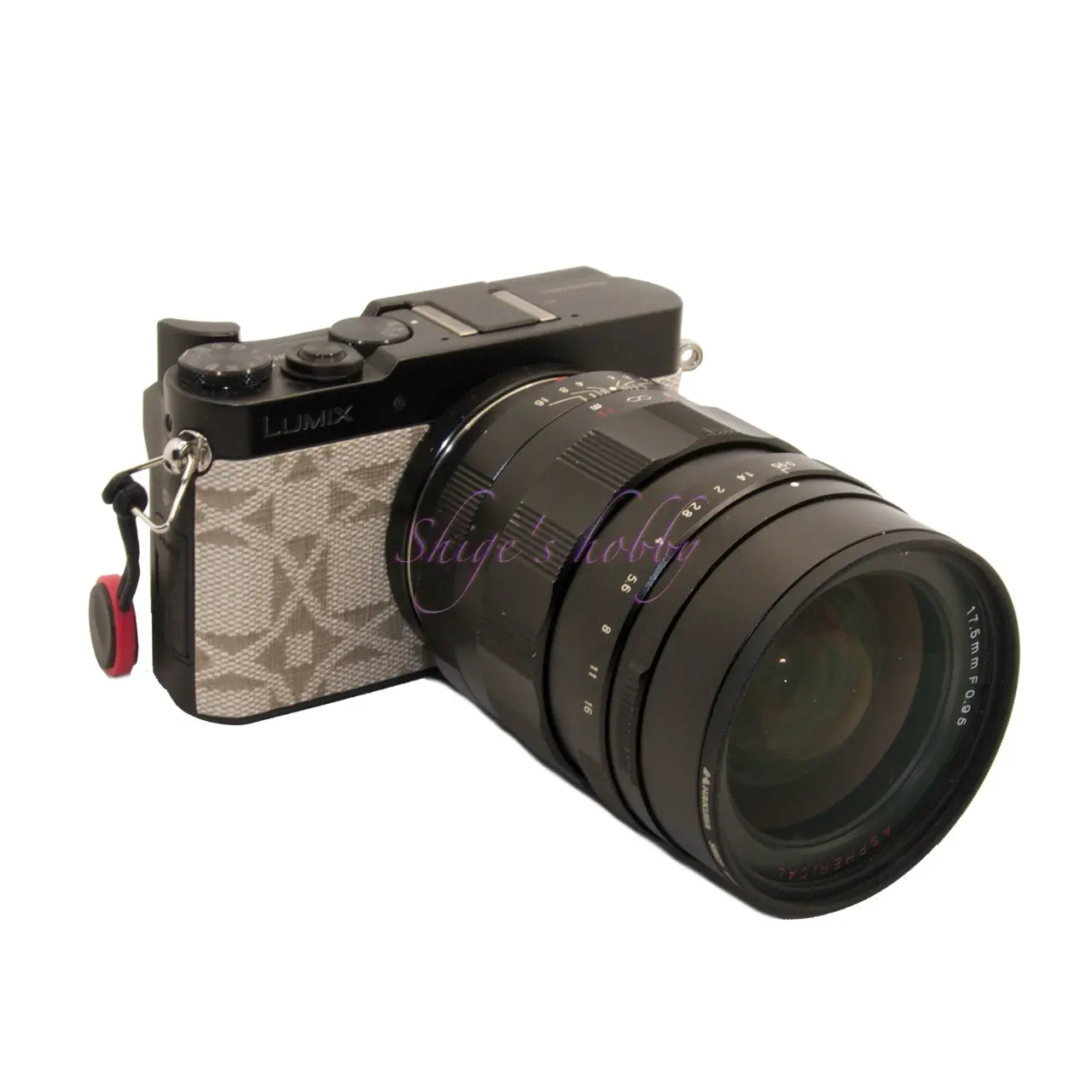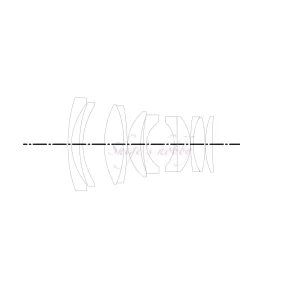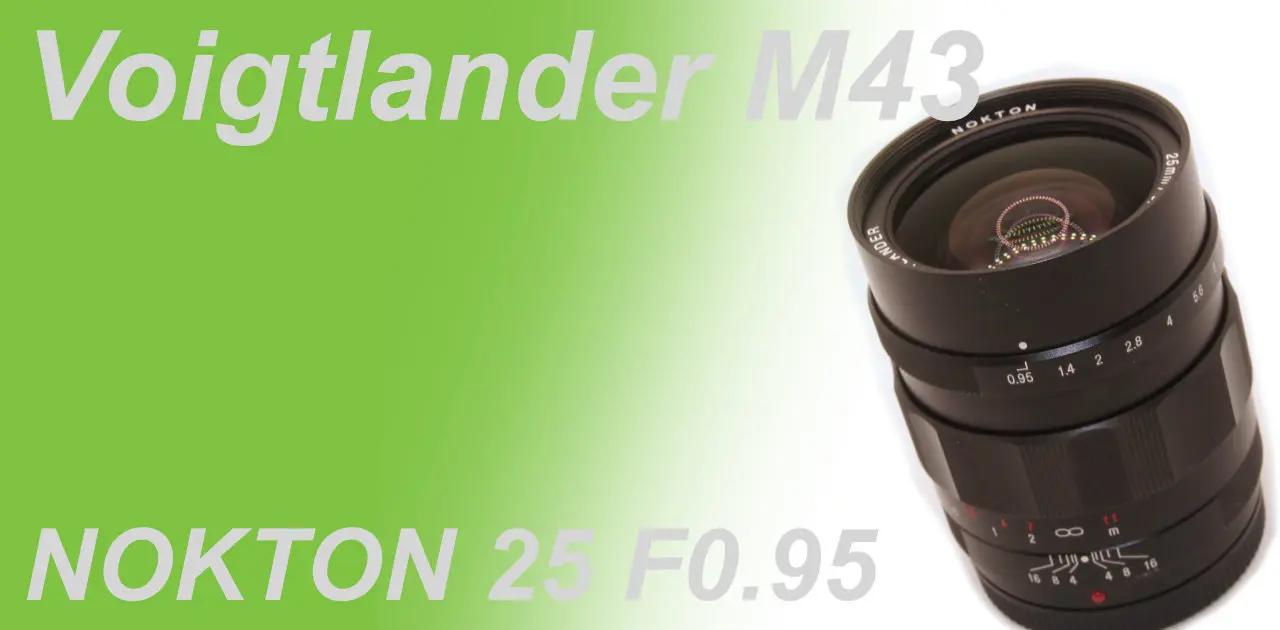Last updated on 2025-10-26
A review and sample photos of the Voigtlander NOKTON 25mm F0.95 Micro Four Thirds Mount used with the Panasonic Lumix DMC-GM5.
- Please see the disclaimer regarding advertising here.
- Italicized links in the text are advertisement links that take you to other sites.
Table of contents
Gallery
The sample photos were taken with a Panasonic DMC-GM5.
Review


1.Overview
The Voigtlander NOKTON 25mm F0.95 is a large-aperture lens for the Micro Four Thirds mount, first released by the Voigtlander brand in 2010. The Type-II, featuring an improved aperture mechanism, was released in 2014.
The lens’s detailed specifications are listed in the table, but the key specifications of the older Type-I are summarized below.
- The focusing mechanism is manual.
- The minimum focusing distance is 0.17m.
- The aperture has 10 blades.
- The filter diameter is 52mm and is attached by screwing it onto the front of the lens.
- A dedicated 58mm cylindrical lens hood is included.
- The lens does not feature a function to disable the aperture click sound for video shooting.
- The new Type-II does feature a function to disable the aperture click sound for video shooting.

2.Usability
The Voigtlander NOKTON 25mm F0.95 is a large-aperture lens from the Voigtlander brand, equivalent to a 50mm focal length in 35mm format when attached to a Micro Four Thirds camera.
The lens does not support autofocus, requiring manual focus. Therefore, when using it at the maximum aperture of F0.95, it’s best to use a camera equipped with a high-resolution viewfinder (EVF).
The electronic viewfinder (EVF) of the Panasonic LUMIX DMC-GM5 used here has a low pixel count of 230,000 dots. Therefore, when relying on the focus peaking display and shooting with this lens at the maximum aperture of F0.95, the focus position ended up being different from the intended position, suggesting a problem with focusing accuracy.
To address this issue, I used the electronic viewfinder’s partial magnification display to confirm that the focus was where I wanted it before taking the photo.
The results show that the image quality is satisfactory for a modern lens. At the maximum aperture of f/0.95, the image is sharp and problem-free at the focal point, while off-focus subjects become rapidly blurred, demonstrating the true joy of using a large-aperture lens.
Setting the aperture to f/4 stabilizes the entire image, allowing you to obtain practically satisfactory images even when relying on the focus peaking display in the electronic viewfinder. These image characteristics are common to the Micro Four Thirds Nokton series.
One concerning aspect of the Nokton 25mm is that, perhaps because its actual focal length of 25mm makes it a wide-angle lens in 35mm format, barrel distortion can be noticeable depending on the shooting distance. It’s unfortunate that barrel distortion is visible at a focal length equivalent to 50mm in 35mm format.
Because the lens does not have the ability to exchange information with the camera, the photographer must adjust parameters to correct it in development software. Lens information such as focal length and aperture value is not recorded in EXIF, so lens information cannot be determined from the image data unless the photographer makes a note of it.
This is the same as when using a Leica M-mount lens via a mount adapter.
When using a lens without electronic contacts with the LUMIX GM5, only the electronic shutter is used, so it is necessary to understand issues specific to the electronic shutter, such as how to deal with flicker and rolling distortion of the subject, and to know how to avoid these issues by changing the camera settings, etc.
3.Summary
In conclusion, to sum up the Voigtlander NOKTON 25mm F0.95 is a large-aperture standard lens. The brightness of F0.95 allows for significant bokeh on Micro Four Thirds sensors. Distortion is noticeable at certain distances and with certain subjects, so we recommend previewing it before purchasing if possible.
It’s also large and heavy for a Micro Four Thirds lens, and can only be used with manual focus, so when purchasing one, you need to consider whether the lens is suitable for your earthquake photography style.
Specifications, considerations, etc.
Voigtlander has released six large aperture lenses for Micro Four Thirds. All of them are bright lenses with an aperture value of over 0.95.
- 10.5mm F0.95 / 21mm
- 17.5mm F0.95 / 35mm
- 25mm F0.95 / 50mm
- 29mm F0.8 / 58mm
- 42.5mm F0.95 / 85mm
- 60mm F0.95 / 120mm
The 17.5mm and 60mm have focal lengths of 35mm and 120mm in 35mm format, and for the 35mm I used the 35mm F1.2, which is compatible with the 35mm format, so you can get a rough idea of the trends. I feel that the 120mm is a bit too long and difficult to use.
Of these, the lenses I would particularly like to try are the 42.5mm and 10.5mm.
- The actual focal length of 42.5mm is close to that of a standard 35mm lens, which is equivalent to 85mm in 35mm format in Micro Four Thirds. The NOKTON 42.5mm has a focal length that makes it easy to reduce the barrel distortion that is a problem with the 25mm, and I am interested in how it will depict images.
- I have used the NOKTON 21mm F1.4, which has an ultra-wide focal length of 10.5mm, which is equivalent to 21mm in 35mm format in Micro Four Thirds, but it will be interesting to see how the brighter NOKTON 10.5mm depicts images.
The 29mm F0.8 is brighter than the other lenses with F0.95 maximum apertures, and although it is designed for Micro Four Thirds, it achieves a maximum aperture of F0.8 at a 35mm equivalent focal length of 58mm. It’s an interesting lens with a unique brightness, but its price of over 200,000 yen is hard to justify for a Micro Four Thirds lens.
I had the opportunity to use all of the lenses at CP+2025, and found that adjusting the focus on any camera with a 2-megapixel EVF was no problem, so these are lenses I’d like to use in sequence.
| Items | 10.5mm F0.95 | 17.5mm F0.95 | 25mm F0.95 TYPE-II | 42.5mm F0.95 | 60mm F0.95 |
| Focal length(mm) | 10.5 | 17.5 | 25 | 42.5 | 60 |
| 35mm equivalent focal length | 21 | 35 | 50 | 85 | 120 |
| Max aperture | 0.95 | 0.95 | 0.95 | 0.95 | 0.95 |
| Min aperture | 16 | 16 | 16 | 16 | 16 |
| Aperture blade | 10 | 10 | 10 | 10 | 10 |
| Lens Construction | 13 elements in 10 groups | 13 elements in 9 groups | 11 elements in 8 groups | 11 elements in 8 groups | 11 elements in 8 groups |
| Min distance(m) | 0.17 | 0.15 | 0.17 | 0.23 | 0.34 |
| Lens length(mm) | 82.4 | 80 | 70 | 74.6 | 87.7 |
| Lens Max diameter(mm) | 77 | 63.4 | 60.6 | 64.3 | 82.5 |
| Filter Size(mm) | 72 | 58 | 52 | 58 | 77 |
| Weight(g) | 585 | 540 | 435 | 571 | 860 |
| Release date | June 12, 2015 | April 29, 2012 | April 8, 2014 (new model) November 25, 2010 (old model) | August 23, 2013 | April 24, 2020 |
| Price(Yen/No-tax) | ¥148,000 | ¥118,000 | ¥105,000 | ¥118,000 | ¥145,000 |
Reference links
Affiliate links
- SHOTEN Mount Adapter m43-SE・Ads by Amazon
- SHOTEN Mount Adapter m43-SE・Ads by Rakuten
- Voigtlander Lens ・Ads by Amazon
- Voigtlander books ・Ads by Amazon
- NOKTON 25mm F0.95 TypeII Micro Four Thirds Ads by Amazon
- NOKTON 10.5mm F0.95 Micro Four Thirds Ads by Amazon
- NOKTON 17.5mm F0.95 Micro Four Thirds Ads by Amazon
- NOKTON 42.5mm F0.95 Micro Four Thirds Ads by Amazon
- NOKTON 60mm F0.95 MFT Ads by Amazon
- SUPER NOKTON 29mm F0.8 Aspherical MFT Ads by Amazon
- PROMINAR 8.5mm F2.8 ・Ads by Amazon
- PROMINAR 12mm F1.8 ・Ads by Amazon
- PROMINAR 25mm F1.8 ・Ads by Amazon
- 9mm f8 Fisheye Body Cap Lens BCL-0980 ・Ads by Amazon

Amazon Prime Sale
Update history
- 2025.9.10



![[商品価格に関しましては、リンクが作成された時点と現時点で情報が変更されている場合がございます。] [商品価格に関しましては、リンクが作成された時点と現時点で情報が変更されている場合がございます。]](https://hbb.afl.rakuten.co.jp/hgb/06ddf1d8.b245f6d5.06ddf1d9.44d5c3c5/?me_id=1202242&item_id=12291818&pc=https%3A%2F%2Fthumbnail.image.rakuten.co.jp%2F%400_mall%2Fmapcamera%2Fcabinet%2Fused_2485%2F3717019498007_1.jpg%3F_ex%3D128x128&s=128x128&t=picttext)
Be First to Comment